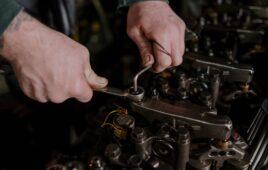By Dr. Jody Muelaner

A selection of tools for installing fasteners.
There are several types of fasteners and so, too, are there several available tools for securing industrial fasteners. It’s just as important to choose the correct tool for installation as it to choose the right fastener for an application. The use of an incorrect tool is a safety concern and can lead to an insecure joint or attachment or a broken or faulty fastener.
However, many general-purpose tools are used for fastening, such as drills to create holes or drive fasteners and hammers to drive nails or align parts. There are also several specialized tools for tightening threaded fasteners, inserting rivets, and applying adhesives or welding. So, it’s important to research which tool is ideal for each application.
Tightening threaded fasteners
Many different tools are used for tightening threaded fasteners because of the variety of heads available and the application. Some projects may have more limited access or versatility than others. Tools for use on threaded fasteners include screwdrivers, spanners, sockets and keys, and drivers. They can also be ratcheting, air-powered, or electrical tools.
Drilling holes
Many types of fasteners, including bolts and rivets, require holes to be drilled before installation. Drill types include hand-held drill-drivers, electric drills, drill presses, milling machines, and orbital drilling machines. Drills and manual milling machines create holes the same size as the drill bit or cutting tool that’s used to create the hole.
When a CNC milling machine or orbital drilling machine creates a hole, the cutting tool is a smaller diameter than the final hole. As the tool advances into the material, it moves in a spiral path. This means the diameter of the final hole will be the diameter of the cutting tool plus the diameter of the spiral path.
This type of drilling produces cleaner holes, lower reaction forces, and less vibration.
Installing rivets
Traditional solid rivets are a highly effective fastener that’s widely used in the construction of aircraft and large steel structures. Hammers and anvils are used to form their heads after the rivets are fitted. This requires access from both sides of the hole, with the anvil placed against one end of the rivet and the hammer striking the other end.
Hand hammers were once used but have been replaced by hand-held air hammers or automated drilling and riveting machines, which use hydraulic or electromagnetic presses.
Blind rivets are installed from one side, by drawing their integral mandrel back through their body. Special riveters are used to draw the mandrel. Manual tools are divided into plier type riveters, which are typically compact and inexpensive, and lazy tong rivet tools, which can install rivets that require great force.
Applying adhesives
Some tools used in the application of adhesives are dispensers, such as caulk guns. Typically, however, adhesives are supplied in containers designed to enable easy application — meaning that serve as tools.
Other tools are an integral part of the bonding process, such as those used to apply heat. Glue guns are a commonly used tool to apply hot glue.
Welding
Welding may be performed using a gas torch, electric arc, ultrasound, or high-energy beam (either laser or electron). Each of these options requires different tools. Different forms of arc welding are used for fastening, including spot welding, stick welding, MIG welding, and TIG welding. These require tools with different power suppliers, supplies of shielding gas, and wire feeds. Angle grinders are typically used to prepare joints for welding.





Tell Us What You Think!